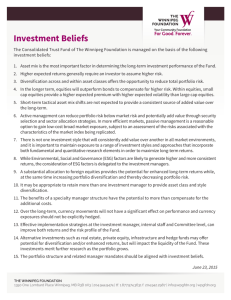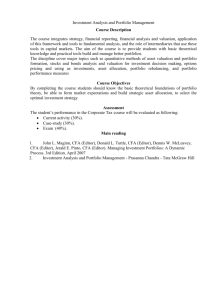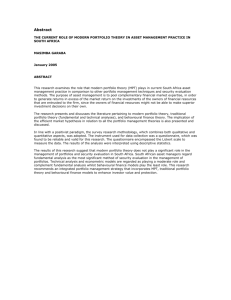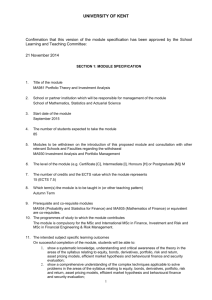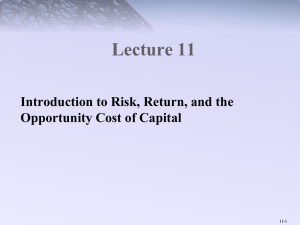“Are You Well Diversified?” What Does That Really Mean?
advertisement
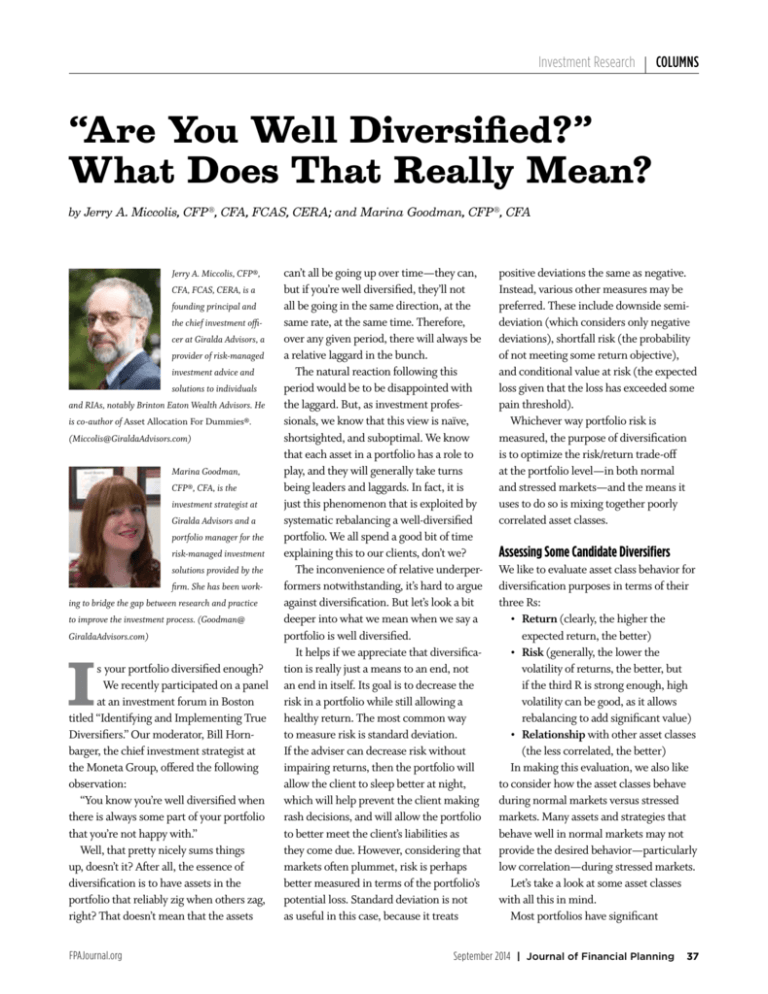
Investment Research COLUMNS “Are You Well Diversified?” What Does That Really Mean? by Jerry A. Miccolis, CFP®, CFA, FCAS, CERA; and Marina Goodman, CFP®, CFA Jerry A. Miccolis, CFP®, CFA, FCAS, CERA, is a founding principal and the chief investment officer at Giralda Advisors, a provider of risk-managed investment advice and solutions to individuals and RIAs, notably Brinton Eaton Wealth Advisors. He is co-author of Asset Allocation For Dummies®. (Miccolis@GiraldaAdvisors.com) Marina Goodman, CFP®, CFA, is the investment strategist at Giralda Advisors and a portfolio manager for the risk-managed investment solutions provided by the firm. She has been working to bridge the gap between research and practice to improve the investment process. (Goodman@ GiraldaAdvisors.com) I s your portfolio diversified enough? We recently participated on a panel at an investment forum in Boston titled “Identifying and Implementing True Diversifiers.” Our moderator, Bill Hornbarger, the chief investment strategist at the Moneta Group, offered the following observation: “You know you’re well diversified when there is always some part of your portfolio that you’re not happy with.” Well, that pretty nicely sums things up, doesn’t it? After all, the essence of diversification is to have assets in the portfolio that reliably zig when others zag, right? That doesn’t mean that the assets FPAJournal.org can’t all be going up over time—they can, but if you’re well diversified, they’ll not all be going in the same direction, at the same rate, at the same time. Therefore, over any given period, there will always be a relative laggard in the bunch. The natural reaction following this period would be to be disappointed with the laggard. But, as investment professionals, we know that this view is naïve, shortsighted, and suboptimal. We know that each asset in a portfolio has a role to play, and they will generally take turns being leaders and laggards. In fact, it is just this phenomenon that is exploited by systematic rebalancing a well-diversified portfolio. We all spend a good bit of time explaining this to our clients, don’t we? The inconvenience of relative underperformers notwithstanding, it’s hard to argue against diversification. But let’s look a bit deeper into what we mean when we say a portfolio is well diversified. It helps if we appreciate that diversification is really just a means to an end, not an end in itself. Its goal is to decrease the risk in a portfolio while still allowing a healthy return. The most common way to measure risk is standard deviation. If the adviser can decrease risk without impairing returns, then the portfolio will allow the client to sleep better at night, which will help prevent the client making rash decisions, and will allow the portfolio to better meet the client’s liabilities as they come due. However, considering that markets often plummet, risk is perhaps better measured in terms of the portfolio’s potential loss. Standard deviation is not as useful in this case, because it treats positive deviations the same as negative. Instead, various other measures may be preferred. These include downside semideviation (which considers only negative deviations), shortfall risk (the probability of not meeting some return objective), and conditional value at risk (the expected loss given that the loss has exceeded some pain threshold). Whichever way portfolio risk is measured, the purpose of diversification is to optimize the risk/return trade-off at the portfolio level—in both normal and stressed markets—and the means it uses to do so is mixing together poorly correlated asset classes. Assessing Some Candidate Diversifiers We like to evaluate asset class behavior for diversification purposes in terms of their three Rs: • Return (clearly, the higher the expected return, the better) • Risk (generally, the lower the volatility of returns, the better, but if the third R is strong enough, high volatility can be good, as it allows rebalancing to add significant value) • Relationship with other asset classes (the less correlated, the better) In making this evaluation, we also like to consider how the asset classes behave during normal markets versus stressed markets. Many assets and strategies that behave well in normal markets may not provide the desired behavior—particularly low correlation—during stressed markets. Let’s take a look at some asset classes with all this in mind. Most portfolios have significant September 2014 | Journal of Financial Planning 37 COLUMNS Investment Research allocations to equities, largely due to their relatively high expected return. Let’s take the presence of equities as a given. A classic diversifier is fixed income. Within fixed income there are many choices. Floating-rate bonds and shortterm high-yield bonds help protect against duration risk while providing higher yields. High-yield bonds behave like fixed income during normal markets, but their performance can become very equity-like during times of market stress. International developed and emerging market debt can provide higher returns as well as currency exposure. Inflation-linked bonds help manage inflation risk. Insurancelinked securities, such as “catastrophe bonds,” are subject to the risk of extreme weather conditions or seismic activity, making them one of the few assets whose performance is largely independent of financial market risks. “Real assets” such as real estate investment trusts (REITs) and master limited partnerships (MLPs) historically have exhibited equity-like levels of growth. One benefit to these assets is that they generally help protect against high levels of inflation. Real estate values and rents tend to rise during inflationary periods. With MLPs, energy infrastructure agreements typically have clauses that adjust prices with inflation. Another type of diversifying investment is represented by alternative strategies. One common alternative strategy is merger arbitrage where the investor goes long the target company and short the acquiring company. A different type of arbitrage strategy takes advantage of the fact that a convertible bond is typically valued differently than the sum of its components (a bond and an equity call). Long/ short and market neutral strategies often have limited exposure to equity markets and their short positions can benefit from market declines. The above asset classes can provide diversification benefits during normal markets. However, during past crises, 38 the correlations of many of these assets to each other materially increased. Just when diversification is most needed, it can disappear. Few asset classes have consistently increased, or at least not decreased, when equity markets plunged. One is the humble Treasury, the star performer in 2008. However, Treasuries are usually too conservative for investors who have liabilities to meet over a long time horizon. Another is precious metals. While this is the asset class of choice for many when there is market panic, they can be very volatile during normal markets and difficult to predict. A class of strategies that tends to do well during both strong bull and bear markets is the category of momentum strategies. They will eventually get the investor out of a falling asset class, limiting the downside. One thing to watch out for is how these perform during normal markets when there is no strong momentum—a good strategy will have mechanisms in place to successfully deal with this scenario. (See our article, “Dynamic Asset Allocation: Using Momentum to Enhance Portfolio Risk Management,” in the February 2012 Journal.) Finally, there are volatility-based strategies. Purchasing puts can protect portfolios during market crashes, but can be quite expensive to carry during normal markets. More sophisticated approaches take advantage of, and monetize, a very reliable relationship—when markets panic, volatility goes up—but do so while aggressively and successfully managing the cost of carry. (See our article, “Integrated Tail Risk Hedging: The Last Line of Defense in Investment Risk Management”, in the June 2012 Journal.) What is particularly interesting about these last two categories—momentumand volatility-based strategies—is that they can be offered within an equity investment without recourse to other asset classes. A growing list of products offer some form of this packaging, bring- Journal of Financial Planning | September 2014 ing us to a rather unconventional way to consider diversification. And Now for a Completely Different View A few of our clients are outside-the-box thinkers and view diversification this way: “We understand that we need equities to fight inflation and to best secure our financial future. Equities are the key ingredient in our portfolio—its real growth engine. We get that. We want equities. We also understand why you have us invested in all those other things—bonds, alternatives, etc.—it’s simply to offset the risk of the equities, is it not?” While one might quibble with it, we have to admit that the above view is not incorrect. With the memory of the 2008/2009 cross-asset-class contagion still a painful scar, our outside-the-box clients continue: “Look, we understand the purpose of the non-equity portion of our portfolio. But, in actual fact, its buffering effect against equities is merely hoped for; it is not direct and it is not guaranteed. So, if we can more explicitly and reliably manage the downside risk of our equities by choosing equity investments that have that kind of risk management already baked in, why do we need anything else?” Now, we have spent our professional investing lives as strong adherents to broad portfolio diversification in the traditional sense. One of us has even co-authored the book Asset Allocation For Dummies®, for goodness sake. Still, when confronted with that last client question (and, trust us, more than one client has so confronted us), we think to ourselves, “Are they onto something?” What Do You Think? Our objective in this column has been to be provocative and to generate dialogue on portfolio diversification, its broader underlying purpose, and various—including non-traditional—ways to fulfill that purpose. We’d be interested to hear what you think about all this. FPAJournal.org

